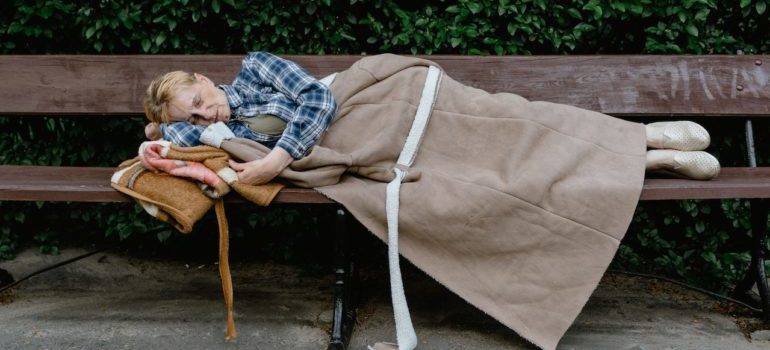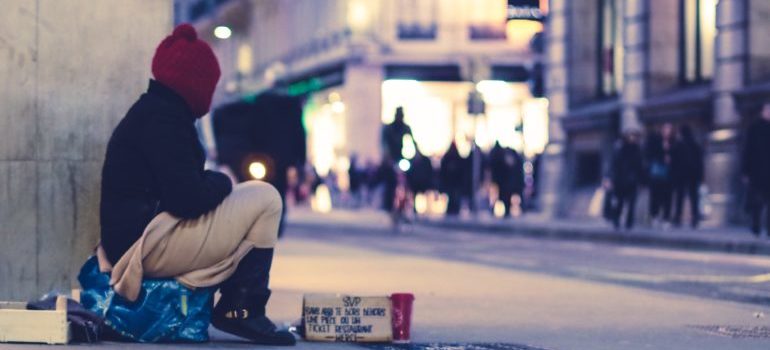Homelessness and Substance Abuse in PA: The Connection and Data to Be Aware Of
Even in the most rural regions in the United States, homelessness is a serious problem. Over 15,000 people in Pennsylvania are homeless on any given night; in the state’s rural districts, known as the Balance of State, that number rises to over 8,000. Many of these people are children. Unfortunately, there is a close connection between homelessness and substance abuse. Many people who are homeless have a history of substance misuse and vice versa. We at Little Creek Recovery recognize that homelessness is one of the biggest risk factors for developing an addiction. That’s why we did thorough research and gathered data that will hopefully help you understand both these issues and their connection.
Jump to Section
The Connection Between Homelessness and Substance Abuse
Homelessness in the US is not a new problem. It was, in fact, during the 1870s that homelessness and drug abuse became widespread problems across the country. The onset of America’s homelessness crisis may be traced back to the industrial revolution, increasing inequality during the Gilded Age, and opium addiction. Today, the number of homeless unfortunately is only growing. The National Alliance to End Homelessness reports that the number of homeless people in the US has increased yearly since 2015. It is projected that 580,466 people in the United States, or about 17% of the population, were homeless as of January 2020. Roughly 26% of them are also abusing substances. Approximately 70% of the homeless population consists of males, with African Americans and Native Americans making up a disproportionately large share.

In some areas of California and New York, homelessness and housing insecurity have reached epidemic proportions, and the situation is only getting worse in other states like Oregon and the District of Columbia. Pennsylvania has the 24th lowest prevalence of homelessness in the US, with an estimated 13,375 people living on the streets. This equates to a rate of 10.4 out of every 10,000 residents! It has been shown through research that expensive housing is a major contributor to people losing their homes and becoming homeless. So it shouldn’t come as a surprise that in states where residents have to devote a larger share of their income to housing costs than the national average, the homeless population is disproportionately high.
Is It Just a Matter of Direct Cause and Effect Relationship?
People who are homeless are often stigmatized as being drug addicts or alcoholics. Many of them would likely say they’ve made some poor decisions in their lives but then again, life can also dish out more than its fair share of tragedy, stress, suffering, and other negative factors that greatly affect our lives. So let us not be too quick to judge.
After years of study, scientists finally have a definitive answer to the “the chicken or the egg” debate. The National Coalition for the Homeless states that substance abuse can function as both a precipitating factor and a perpetuating factor in a person’s experience of homelessness. To make the matter more complicated, the underlying cause of addiction, and later homelessness often lies in mental health issues. Given this, it’s clear that common misconceptions about addicts and the homeless are unjustified.
Most Common Reasons Behind Homelessness
Despite the fact that substance abuse plays a role, there are many more causes of homelessness besides that. Here are the most common reasons behind homelessness:
- Health issues and poor physical health.
- Mental health problems and a family history of schizophrenia, bipolar disorder, anxiety disorders, post-traumatic stress disorder, or personality problems.
- Substance abuse disorders (alcohol, opioids, crack cocaine, and other drugs).
- Living or associating with people who use drugs and/or alcohol to a significant degree.
- Homelessness (combined with substance abuse) is also common among military veterans.
- Early childhood separation or similar trauma.
- Lower level education.
- Financial difficulties vary from low income to no income and poverty.
- Overcrowded or unstable housing situation.
- Unemployment and lack of employment opportunities.
Many persons who are homeless have a history of substance addiction and/or a mental health condition, and others who are homeless try to cope with their situation by drinking or using drugs. The terms “social selection” and “social causation” describe these two possibilities.
Social Selection
The social selection hypothesis, which suggests that substance abuse problems are a possible entry point for the homeless, is supported by the vast majority of the available evidence. About two-thirds of homeless people point to substance abuse as a major, if not the leading, contributor to their situation. In reality, many people living on the streets have admitted that they struggled with substance abuse before becoming homeless. Substance abuse is a major risk factor that reduces one’s resilience to the pressures of daily living. Therefore, it is critical for those who are experiencing substance addiction issues to get help before the issue causes problems at home, at their job, with money, with health, or with finding a place to live.
Social Causation
Drug and alcohol abuse is frequently associated with unresolved childhood issues, marital troubles, or co-occurring psychiatric conditions, and this holds true for everyone from well-known, wealthy celebrities to regular, working-class people. That’s why it shouldn’t come as a shock that drug abuse is so common among the homeless. Those who suffer from mental illness, emotional distress, or the rigors of homeless life may resort to alcohol and drug use as a coping mechanism. As early as 1946, scientists hypothesized that homelessness and associated circumstances led to alcoholism in one-third of the population living on the streets. But we’ll dive into this deeper in the following paragraph.
Homelessness as the cause of substance abuse
Contrary to common belief, addiction among the homeless is often a consequence of homelessness and not always the root cause. Due to the stresses of living on the streets, such as constant fear of assault, hunger, and abandonment, some homeless people also acquire mental health issues. Criminal victimization, mental illness, and substance abuse are all more common among the homeless than among the general population. That shouldn’t come as a surprise given that living on the streets is incredibly stressful because of the ongoing struggle to meet basic needs (such as eating and staying healthy) as well as the isolation from loved ones that results from it.
Risk Factors and Causes for Substance Abuse Among Homeless Population
Substance abuse is prevalent among the homeless for many reasons and risk factors including:
- Self-medication. Many people turn to drugs in order to cope with life’s difficulties.
- Lack of support system. Homeless people usually have minimal or no interaction with loved ones.
- Experiencing trauma. Sixty-eight percent of men and seventy-six percent of women in homeless drug abuse treatment reported experiencing trauma.
- Chronic medical issues. Statistics show that people who are homeless and also struggle with substance abuse are more likely to experience health issues such as HIV/AIDS, hepatitis B and C, heart disease, dental issues, asthma, and diabetes.
- Substance abuse is normalized. One study found that substance abuse was more widely accepted among the homeless. This leads to the conclusion that substance availability is increased in homeless areas.
- Untreated mental illness. As a means of self-medicating for the symptoms of their mental illness, many persons experience both mental illness and substance abuse. Additional stresses, such as the greater risk of assault and victimization, commonly confront homeless people with mental illness and substance misuse difficulties, which can feed the cycle of addiction and prevent recovery.
Homeless Women and Substance Abuse
Even though 70% of the homeless population consists of males, women are more likely to abuse drugs because of the gender-specific trauma most of them experience. While mental illness affects 30% of the homeless population as a whole, it affects a much higher percentage of women. Between fifty percent and sixty percent of women who are homeless experience mental and emotional difficulties, and these problems generally begin long before they become homeless. But when homelessness and substance misuse are present, these disruptions tend to worsen.

Many women who end up on the streets have been victims of marital abuse or sexual assault. Some have even survived sex trafficking. Around one-third of homeless women have tried heroin or crack cocaine, and this is likely due to these causes and the co-occurring disorders that often accompany homelessness.
Homelessness, Mental Illness, and Substance Abuse
Approximately one-third (33%) of homeless people are also dealing with mental health issues. According to many reports, mental illness is a significant contributor to homelessness. Homeless people often suffer from a variety of mental health issues, including:
- Bipolar disorder.
- Schizophrenia and psychotic/affective disorders associated with it.
- PTSD or post-traumatic stress disorder (particularly high in homeless veterans).
- Clinical depression.
- Extreme anxiety.
Mentally ill homeless people struggle even more than average homeless people and are more likely to become victims of an assault. This increases the urgency with which they seek the temporary solace that can be found in drugs. On top of that, a lot of homeless people with mental and emotional disorders turn to dangerous substances to self-medicate and alleviate their symptoms. However, this is actually the beginning of a vicious cycle of dependence that only strengthens the link between homelessness and substance abuse.
Homelessness and Substance Abuse Among Younger Population
Substance abuse is a major problem among the homeless population, particularly among young people. Homelessness is more common among 12-17-year-olds than among adults. On top of that devastating fact, many homeless adolescents experienced abuse and severe trauma, usually from people closest to them. And the saddest part is that 71% of children who were reported missing, runaway, discarded, or abducted had a substance use condition (SUD).
Some of the causes of substance addiction and homelessness among young people are:
- Growing up in a homeless family or having one parent that’s homeless.
- Family history of substance abuse.
- Family abuse and violence.
- Lack of coping mechanisms for dealing with stress.
- Chronic medical conditions or co-occurring disorders.
- Substance misuse at a young age.
- Physical, emotional, sexual, or any other kind of abuse.
- Running away from the family home.
Unfortunately, in the absence of treatment, substance misuse and co-occurring disorders are more likely to persist into adulthood among homeless kids.
Vulnerability of Homeless People with Substance Abuse Issues
Every person living on the streets faces danger from violent encounters, the effects of untreated medical and psychological issues, and the hazards of outdoor life. Therefore, addiction recovery is much more challenging for homeless drug addicts. Increased danger of violence and victimization, as well as a high turnover rate between the streets, jails, and emergency rooms, are only some of the additional barriers to treatment for homeless people who also suffer from mental illness and substance abuse.
Another major hurdle is a lack of desire to discontinue drug use. Finding food and shelter sometimes takes precedence over other forms of help for those who are homeless. On top of that, many people who are currently homeless have also grown distant from their social networks. Addiction recovery is far more challenging without a strong social support system. Despite their success in kicking their drug habits alone or through various recovery programs, recovering addicts may struggle to maintain their sobriety on the streets.

Many homeless drug misuse programs do not accept persons with mental health issues. On the other hand, many mental health programs do not treat people who are homeless. Even most shelters won’t take you if you show up drunk or high. This makes alcoholics and drug addicts among the most vulnerable populations. In order to reduce the likelihood of relapse, having a secure place to live is essential throughout and after addiction treatment.
Final Thoughts on Homelessness and Substance Abuse
Both separate and combined, homelessness and substance abuse are two major issues that require urgent attention. The good news is that there are methods to make support more accessible to persons battling substance misuse and homelessness. Since housing is the main concern, government-funded rehab programs like Housing First treat a person’s housing concerns first and then offer a personal choice as to whether the individual wants to address their mental health and substance misuse issues afterwards. Plus, there are plenty more initiatives and efforts pointed towards resolving these problems.
In case you or your loved one are struggling with substance abuse, it’s crucial to seek a drug and alcohol treatment center in Pennsylvania as soon as possible. Substance abuse almost inevitably leads to addiction. Addiction, however, can turn your life around and make you lose everything you love. So don’t wait and get the support and help you need now!